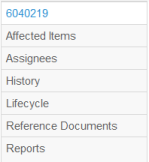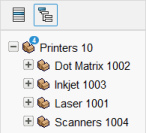 ENOVIA Application Window
ENOVIA Application Window ENOVIA Application Window
ENOVIA Application WindowThe ENOVIA Application Window includes a variety of features for accessing, viewing, sorting, filtering, exporting, and printing PLM data.
To hide the App Panel or Category Tree and provide more screen space for the main content pane, click on the left of the ENOVIA window.
To display the App Panel or Category Tree when hidden, click on the left of the ENOVIA window.
Click on the areas themselves or the call outs to access more information on each:
When an object is selected, it opens in the main window or a child window, depending on the context.
The ENOVIA object window displays the following areas:
Click on the areas themselves or the call outs to access more information on each:

The category tree displays all the functionality available for the displayed object, depending your project role access.
Select a link on the category tree to display the corresponding information in the content pane.

Some objects that deal with hierarchies of related items default to the Structure Tree view when accessed.
Use the Categories button, , to switch to the category tree view.
Use the Structure View button, , to switch back to that view.
The structure tree is shown for certain objects such as Libraries and product hierarchy items.
Structure tree shows the placement of the current object in the context of hierarchy structures.
When a folder or other structure tree item is accessed, the category tree changes to corresponding selection.

When an object has a structure tree view, it is the default view for the object, but the category tree is also available.
Use the Categories button, , to switch to the category tree view.
Use the Structure View button, , to switch back to that view.